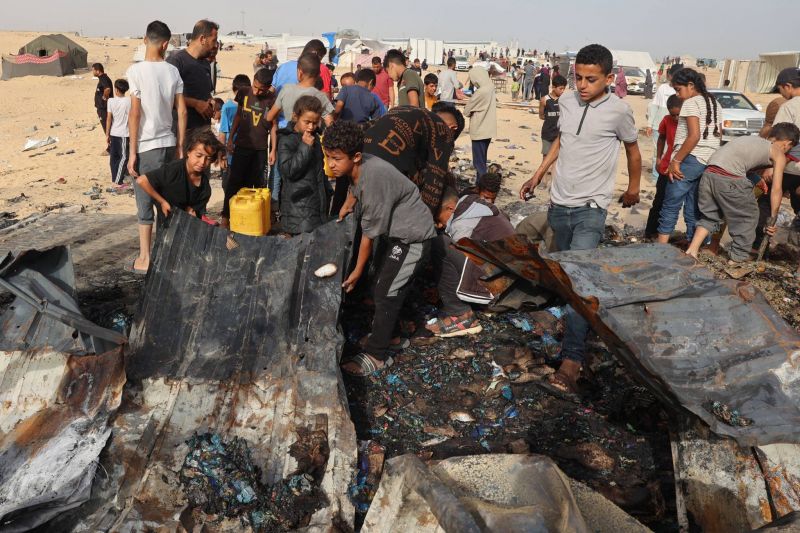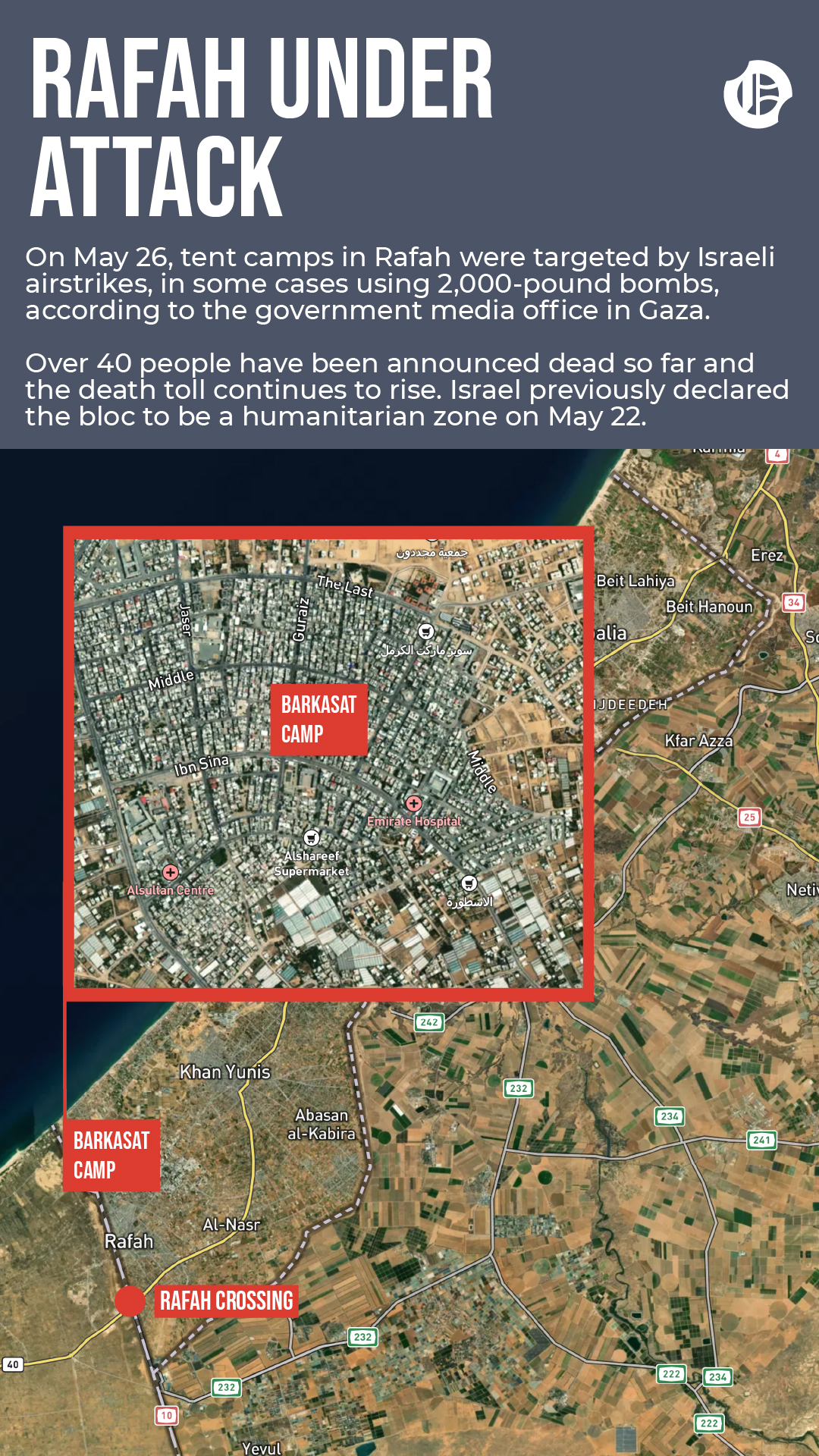
Palestinians inspect what remains of a camp for the displaced in Rafah targeted by the Israeli army on Sunday evening, pictured here on May 27, 2024. (Credit: Eyad Baba/AFP)
Heart-wrenching videos of charred bodies, burning tents, and the sounds of screams in Rafah, southern Gaza, have circulated online since Sunday evening, following several Israeli strikes on al-Barkasat camp for the displaced. The attacks killed 45 people, some of whom were reportedly "burned alive," according to the most recent statements from the enclave.
What do we know about this bombardment, which has roused an outcry of condemnation from all over the world?
The death toll
The Gaza Health Ministry announced on Monday afternoon that 45 people had been killed, the majority of whom were civilians — men, women, and children. WAFA news outlet cited the Palestinian Red Crescent saying that many of the victims had been "burned alive" in their tents. The attack triggered a huge fire that was extinguished by the Palestinian Civil Defense after 45 minutes, Al-Jazeera reported.
Among the horrific images from the aftermath of the strike are bodies burned stiff with arms still reaching out, people being carried unconscious from the burning tents, the remains of a child decapitated by the strike, and a man holding a baby too shocked to cry. Wailing siren mingle with the screams of survivors, as people rushed to tend the wounded.
The camp
Multiple Palestinian sources, including the Red Crescent and Civil Defense, confirm the strike hit a recently established "center for displaced people in Rafah," near UNRWA distribution centers.
A Gaza Civil Defense official told the Washington Post that this location was designated as a “safe humanitarian zone” by the Israeli army. But the block in which the camp is located does not appear on the map of such zones published online by the Israeli army.
The attacked camp, known as "Barkasat," is in the Tall al-Sultan neighborhood of western Rafah. Israel had advised residents in the eastern part of Rafah to evacuate in early May. No orders were given for this western area.
WAFA reports that the region housed “thousands of displaced people.”
 Infographic by Jaimee Lee Haddad
Infographic by Jaimee Lee Haddad
The munitions used
There is no official confirmation of the type and number of munitions used. WAFA reported eight missiles were used, while Al-Jazeera reports seven missiles.
The Palestinian ambassador in London said the army used "2,000-pound bombs," possibly the "Mark 84 (Mk 84)" bombs. These American-made unguided munitions explode into more than 14,000 fragments, sending shrapnel flying over a one kilometer radius.
According to the New York Times, a shipment of 3,500 bombs of this type was suspended by the United States on May 11. An investigation carried out by the American newspaper in December found that this type of bomb was "responsible for some of the worst attacks on Palestinian civilians since the start of the war in Gaza."
The Israeli version
The Israeli army claimed to have targeted "a Hamas compound in which important terrorists were operating," and stated that the operation had eliminated two Hamas officials with roles in the group's presence in the West Bank. They were Yacine Rabia, Hamas chief of staff in Judea and Samaria, and Khaled Nagar, a senior member of the Islamist group.
A statement posted Israeli army's X account says Yacine Rabia "managed all Hamas terrorist activities in Judea and Samaria [in the occupied West Bank], transferred funds to terrorist targets and planned terrorist attacks." Khaled Nagar was described as a "senior official at Hamas headquarters in Judea and Samaria."
"The strike was carried out against targets legitimate under international law, using precise munitions and on the basis of accurate intelligence," the Israeli army said, in a statement attempting to justify its actions against a wave of condemnation.
It said it was "aware of reports that several civilians in the area were injured," though "the details of the incident are still under investigation," said the army's chief legal advisor, Yifat Tomer Yerushalmi during a conference.
Yerushalmi said that she takes the "allegations" of civilians struck in Rafah "very seriously," as per a Haaretz report.
The context
The strike came a day after Hamas launched its first attack on Tel Aviv in months. The Israeli army reported eight rockets fired from Rafah. Sirens sounded, sending people in the major Israeli city running for shelter, but there were no injuries.
On Friday, the ICJ ruled on additional measures that Israel must "immediately halt its military offensive and any other action in the Rafah governorate which may inflict on Palestinian group in Gaza, conditions of life which would bring about its physical destruction in whole or in part" — having found that Israel’s efforts at evacuating and protecting civilians in Gaza were “insufficient."
The ICJ's decisions are binding, but it has no means of enforcing them.
This article originally appeared in French on L'Orient-Le Jour. Translated to English by Amelia Hankins.
